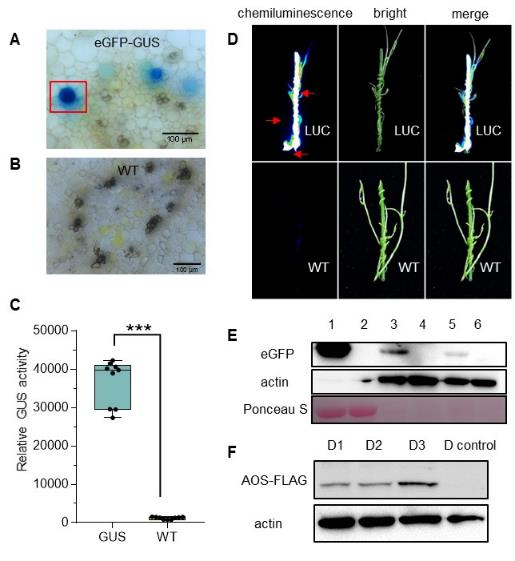There are 4000-5000 species of parasitic plants in nature, accounting for 1% of angiosperms. Dodders (Cuscuta, Convolvulaceae) are widely distributed holoparasites, and namely, they have very little or no photosynthesis activity.
Dodders are root- and leaf-less. They must rely on host plants to survive. Dodder coils around the host stem and develops a specialized organ named haustoria to penetrate into the host stem, in which dodder builds xylem-xylem and phloem-phloem connections with the host plant to obtain water and nutrients.
It has been reported that viruses, phytoplasma, RNAs, some proteins, and secondary metabolites can be transported from host to dodder. Whether there are inter-plant translocations of proteins between dodder and host plant remained unclear.
Recently, WU Jianqiang’s group from the Kunming Institute of Botany, Chinese Academy of Sciences (KIB/CAS) reported that large numbers of proteins can be transported between the dodder Cuscuta australis and its host plant.
The proteomic analyses showed that hundreds to more than 1500 proteins moved between dodder and host plants, and hundreds of foreign proteins can even be translocated into the seeds of dodder and host plants.
In nature, a dodder parasite often simultaneously parasitizes two or multiple host plants, forming dodder-connected plant clusters.
In Arabidopsis-dodder-soybean clusters, research team found that more than 700 proteins were translocated between two different hosts through the dodder connections.
Importantly, more than 11.5% of the transported proteins remained at least 50% of their original abundance after long-distance translocation.
Using Arabidopsis plants expressing different reporter proteins, research showed that these reporter proteins could travel between plants, and they retained their activity in the foreign plants.
Thus, it is likely that some of the transported proteins may retain their biological functions after long-distance inter-plant translocation, and these proteins may affect the growth and development and stress resistance of the recipient plants.
This study is the first illustration of extensive inter-plant protein communication. Given that dodder has a very wide host range (across many plant families), proteins with the same functions can be exchanged or transferred.
Importantly, lineage-specific proteins with novel functions can also be transferred to the recipients through haustorial connections, between dodder and hosts and among phylogenetically distant host plants, which may endow the recipient plants with novel traits.
This study underscores another layer of plant-plant interactions, in addition to those previously identified to be mediated by mRNAs, small RNAs, secondary metabolites, and systemic signals.
This dodder-host interaction system can also be used as a new and powerful system to study long-distance translocation of biomolecules (including signals) in plants.
This work was published online in the Molecular Plant entitled “Extensive inter-plant protein transfer between Cuscuta parasites and their host plants”.
This work was supported by the Strategic Priority Research Program of the Chinese Academy of Sciences, the National Natural Science Foundation of China, CAS Youth Innovation Promotion Association, and the International Partnership Program of the Chinese Academy of Sciences.


Figure 2. Five fusion proteins eGFP-GUS, GUS, LUC, eGFP, and AOS-FLAG can be translocated from Arabidopsis into dodder stems. (Image by KIB)
Contact:
YANG Mei
General Office
Kunming Institute of Botany, CAS
email: yangmei@mail.kib.ac.cn
(Editor:Yang Mei)




